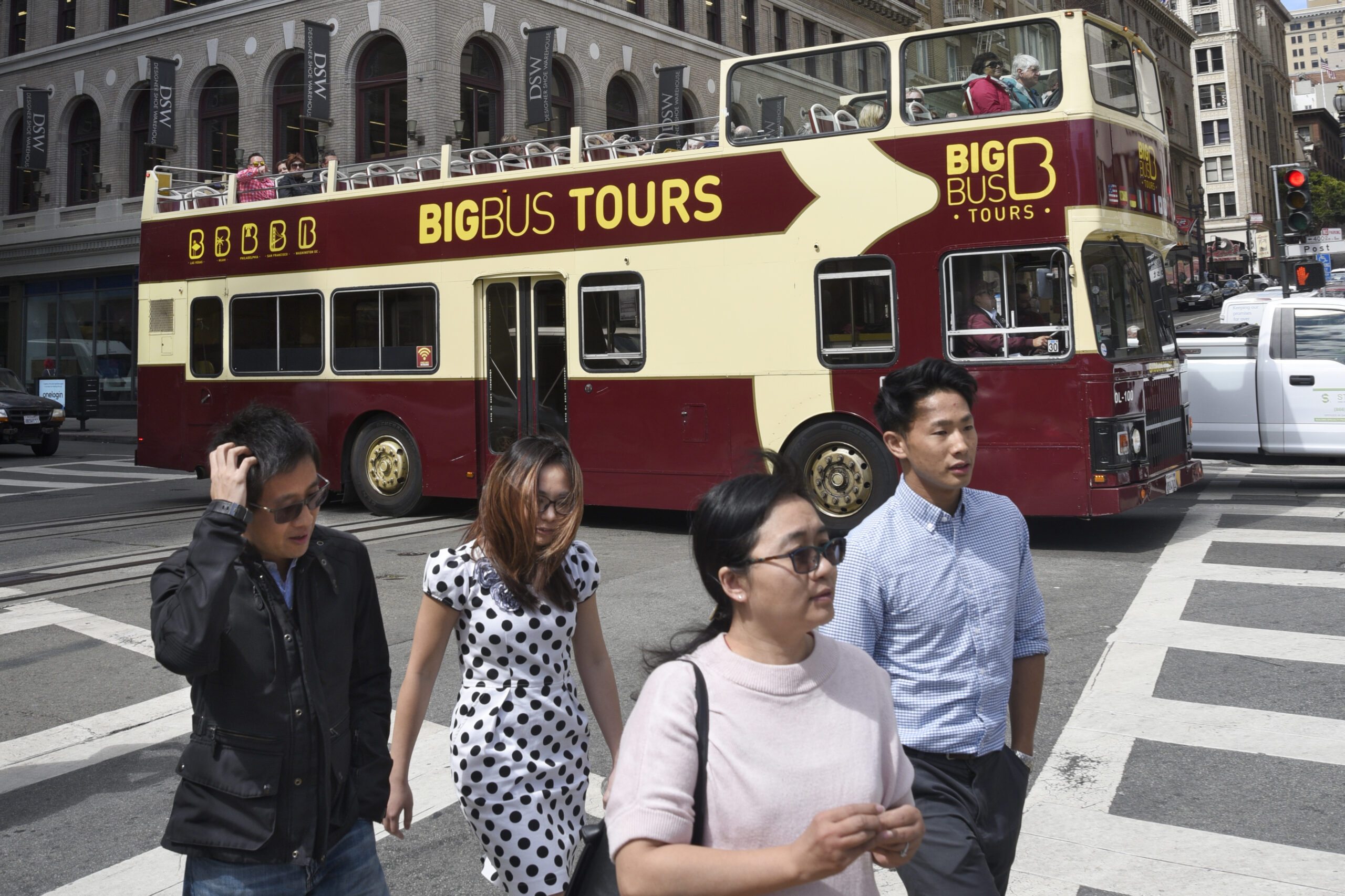San Francisco’s tourism sector is banking heavily on the return of visitors from Asia—particularly Chinese tourists—as it looks to get back on its feet after a difficult few years.
That was one of the major themes of San Francisco Travel’s 2023 Marketing Conference on Tuesday at the Warfield Theater in the Mid-Market neighborhood. Although domestic travelers always make up the majority of visitor traffic coming into the city, international travelers tend to spend more money while they’re visiting. International travelers drove 60% of overnight tourism spending in 2022.
“We expect to see some upside coming out of Asia in the second half of this year, which has been a major part of our international travel,” said Brett Allor, senior director of market strategy and research at SF Travel, during a presentation. “[San Francisco] is the most reliant on international travel and business travel of any market in the region.”
Continuing Covid restrictions in key Asian markets, most notably China, are holding back a full recovery in international tourism spending. International travelers spent $3.7 billion in the city last year—up from $1 billion in 2021, but below the $5.1 billion spent in 2019.
When the Chinese government announced the end of its restrictive “zero-Covid” policies on Jan. 8, many expected a flood of tourists coming to the U.S. But that hasn’t exactly materialized just yet.
Melissa Andretta, director of aviation marketing and development at San Francisco International Airport (SFO), said on a panel that in 2019, the airport had 34 weekly nonstop flights to mainland China. That number is now down to four, though many travelers are finding their way into the U.S. through alternative means, including from Tokyo and Hong Kong, according to Andretta.
Chinese carriers were ready to reopen flights to San Francisco, but have been stymied because of the difficult political situation between the U.S. and China along with their own challenges ramping up long-haul routes, she added.
In the pre-pandemic era, China was San Francisco’s top international market, responsible for 500,000 visitors and some $1.2 billion in spending. Prior to Jan. 8, however, Andretta said Chinese travel was at 10% of 2019 levels.
Pent-Up Demand
Humphrey Ho, a managing partner at Chinese digital advertising firm Hylink, noted that San Francisco has increased in popularity as a travel destination for Chinese tourists. Although it ranks as No. 3 among U.S. destinations, it has moved up from No. 12 to No. 10 when it comes to cities globally for Chinese tourists, based on web search traffic data.
Ho said that travel from China to regional destinations like Singapore, Seoul and Tokyo have returned to pre-pandemic levels. Travel to San Francisco will come back more slowly, but will be led by a different—and higher-spending—visitor.
“Group travel (from China) is not coming back to San Francisco until 2024 at least,” Ho said. “The traveler you will anticipate finding their way to the U.S. are high net-worth and stay a significant amount of time. We’re talking about the upper middle-class of China, which includes around 105 million people.”
In destinations like Singapore and London, which have seen a faster return of Chinese travel, Ho said spending on hotels and flights is up. Ho said his firm has seen recent Chinese travelers spend around $8,000 on airfare and hotels, up from $5,500 in 2019.
A few major travel periods for Chinese tourists are coming up. Among them are the early May labor holiday, summer vacations in August and October’s Golden Week holiday, which is traditionally a major travel season and is expected to be larger due to pent-up demand, according to Ho.
Research conducted by Destination Analysts revealed how the mix of visitors changed between 2019 and 2022. Among the major differences is the racial makeup of the city’s tourists, in part driven by the different international mix of visitors. Last year, San Francisco saw a significant influx of travelers from Europe.
Total tourism spending in 2022 reached $7.66 billion, more than double the $3.69 billion figure for 2021, but still around 74% of the spending seen during 2019’s peak year.
Moscone Center
Hotel bookings tied to events at the Moscone Center—a closely tracked industry metric—have started to rebound after a nadir in 2021. Industry analysts are projecting around 672,000 Moscone room nights this year, similar to levels seen in 2018. Next year looks to be a down year, however, with only 21 events and 456,181 definite room nights for 2024.
SF Travel said closing the gap is a major priority and said the Moscone Center is offering booking discounts and the organization is doubling the number of staff in their convention sales and events staff.
But travel officials also raised familiar complaints about public safety and general street conditions in and around San Francisco’s main tourist hubs.
“Street conditions and pricing continue to negatively impact the pace (of recovery),” Allor said. “We’re constantly working on retaining business rather than trying to win new business.”
Public safety was the subject of a panel that featured Rachel Moran, acting deputy chief of the San Francisco Police Department and District Attorney Brooke Jenkins, who touted a stronger relationship between the police department and the DA and highlighted differences with her predecessor in the office.
In response to an audience question about smash-and-grab robberies deterring new visitors, Moran said the department has been trying to organize its plainclothes officers to take down robbery crews and have been using staff at SFO to educate travelers about best practices to avoid being a robbery target.
